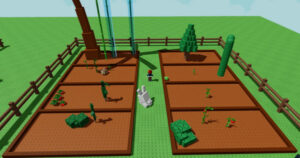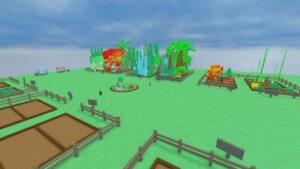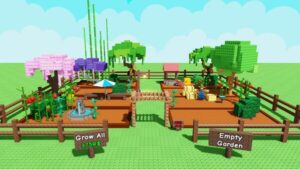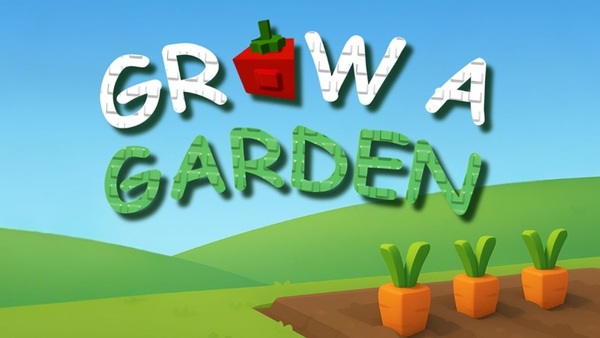Advertisement
Popular Now
"Grow a Garden" isn't just a game; it's a tranquil escape into the rewarding world of digital horticulture. Whether you're a seasoned green thumb or a complete novice, this charming simulation offers a delightful journey from barren plot to flourishing paradise. This comprehensive "How To" guide is designed to empower you with the knowledge and strategies needed to maximize your garden's potential, ensuring every seed you sow blossoms into a vibrant success. We'll walk you through the essential steps, from initial setup and crop selection to advanced techniques for optimization and aesthetic appeal. Prepare to transform your digital space into a thriving, beautiful, and productive garden!




Laying the Foundation: Setting Up Your First Plot
Every magnificent garden begins with a single, well-prepared plot. In "Grow a Garden," your initial setup choices dictate your early game progress and set the stage for future expansion. Don't rush this crucial first step; a little planning goes a long way. When you first launch "Grow a Garden," you'll be greeted with a pristine, empty plot. Your immediate goal is to establish the basic infrastructure for your gardening endeavors. This involves choosing your initial plot size, determining the layout, and considering factors like accessibility and future growth. Start small and manageable, especially if you're new to the game. A compact 5x5 or 10x10 plot is ideal for learning the mechanics without feeling overwhelmed. As you gain experience and resources, you can gradually expand your gardening empire. Remember, a well-organized garden is not only efficient but also aesthetically pleasing.Choosing Your Initial Plot Size
- Small (e.g., 5x5):
- Pros: Easy to manage, low resource investment, quick to learn basic mechanics.
- Cons: Limited crop yield, slower progression in the early game.
- Ideal for: New players, those who prefer a relaxed pace, or focusing on specific, high-value plants.
- Medium (e.g., 10x10):
- Pros: Good balance of yield and manageability, decent early-game progression.
- Cons: Requires slightly more initial resources and attention than a small plot.
- Ideal for: Players looking for a steady start with room for moderate expansion.
- Large (e.g., 20x20+):
- Pros: High potential for crop yield and rapid progression, suitable for advanced players.
- Cons: Demanding in terms of resources and time, can be overwhelming for beginners.
- Ideal for: Experienced players aiming for large-scale production and significant in-game currency.
Essential Early Game Tools and Structures
Once your plot is chosen, focus on acquiring the basic tools. A watering can is your most fundamental tool, allowing you to hydrate your crops. Next, invest in a shovel for digging holes and removing unwanted plants. Consider purchasing a small storage shed early on; this helps keep your inventory organized and prevents valuable resources from cluttering your plot. Lastly, don't forget the seed packets – your garden won't grow itself! Start with common, fast-growing crops like carrots or radishes to quickly accumulate initial funds and experience.Seeds of Success: Understanding Plant Types and Selection
The heart of "Grow a Garden" lies in its diverse array of plants. Each seed boasts unique characteristics, from growth time and water requirements to yield and sell price. Understanding these nuances is key to optimizing your garden's output and maximizing your profits. Before planting, take a moment to research the different seed types available. The game typically categorizes plants by their growth cycle (e.g., quick-growing, seasonal, perennial), resource needs (water, fertilizer), and rarity. For beginners, it's wise to start with common, fast-growing vegetables that have low water requirements. These provide quick returns on your investment and allow you to rapidly accumulate the funds needed for more specialized crops. As you progress, you'll unlock rarer and more profitable seeds, but these often come with higher demands and longer growth times.Categorizing Your Crops
- Vegetables:
- Examples: Carrots, Radishes, Tomatoes, Potatoes.
- Characteristics: Generally fast-growing, provide consistent income, good for early game. Some may require specific soil types or trellises in later stages.
- Strategy: Plant in bulk for steady cash flow.
- Fruits:
- Examples: Strawberries, Blueberries, Apples (from trees).
- Characteristics: Often have longer growth cycles than vegetables but yield higher profits. Fruit trees are typically long-term investments.
- Strategy: Interplant with vegetables for a balanced income stream.
- Flowers:
- Examples: Roses, Tulips, Sunflowers.
- Characteristics: Primarily for aesthetic appeal, often used for crafting decorative items or selling for a moderate profit. Some may attract beneficial insects.
- Strategy: Plant in designated aesthetic zones or to meet specific crafting goals.
- Herbs:
- Examples: Mint, Basil, Lavender.
- Characteristics: Can be used for crafting potions, recipes, or sold for niche profits. Often have unique environmental benefits (e.g., pest repellent).
- Strategy: Grow in smaller quantities as needed for crafting or specific quests.
Strategic Crop Rotation and Companion Planting
As your garden expands, consider implementing crop rotation. This involves changing the type of crop grown in a specific plot each season. It helps maintain soil health, prevents nutrient depletion, and reduces the buildup of pests and diseases. Some crops, like legumes, can even enrich the soil with nitrogen, benefiting subsequent plantings. Furthermore, explore companion planting, where certain plants benefit from being grown near each other. For example, some flowers can deter pests from vegetables, while others can attract beneficial pollinators, boosting yields. Experiment with different combinations to discover synergistic relationships within your garden.The Art of Nurturing: Watering, Fertilizing, and Pest Control
A truly thriving garden requires more than just planting seeds; it demands consistent care and attention. Proper watering, timely fertilization, and vigilant pest control are the pillars of a successful harvest in "Grow a Garden." Every plant in your garden has specific needs. Watering is fundamental; dehydrated plants will wilt and eventually perish, leading to wasted effort and resources. Pay attention to the moisture levels of your soil, indicated by visual cues or in-game meters. Early in the game, a manual watering can suffice, but as your garden grows, investing in a sprinkler system or automated irrigation becomes a significant time-saver. Likewise, fertilization is crucial for boosting plant growth, increasing yields, and enhancing the quality of your produce. Different fertilizers offer varying benefits, so choose wisely based on your crop's needs.Mastering Watering Techniques
- Manual Watering:
- Pros: Precise control, no initial cost.
- Cons: Time-consuming for large gardens, requires constant monitoring.
- Strategy: Ideal for small plots or specific, high-value plants that need individual attention.
- Sprinkler Systems:
- Pros: Automates watering, saves time, covers large areas efficiently.
- Cons: Initial investment cost, may not be suitable for all plant types (e.g., those that prefer drier conditions).
- Strategy: Prioritize for large plots with uniform watering needs. Upgrade to higher-tier sprinklers for better coverage and efficiency.
- Hydroponics/Advanced Irrigation:
- Pros: Highly efficient, precise nutrient delivery, often faster growth.
- Cons: Significant late-game investment, complex setup.
- Strategy: For expert players aiming for maximum yield and automation.
Combating Pests and Diseases
Even in a digital world, your garden can face challenges. Pests and diseases can wreak havoc on your crops, reducing yields and potentially spreading to other plants. Regularly inspect your garden for any signs of infestation, such as wilting leaves, discolored spots, or visible bugs. Early detection is key. Invest in pesticides or organic repellents to combat common garden nuisances. Some plants, as mentioned in companion planting, can naturally deter pests. Additionally, ensuring proper plant spacing helps improve air circulation, reducing the likelihood of fungal diseases. Maintaining diverse plant life also promotes a healthier ecosystem, making your garden more resilient to threats.Harvesting and Selling: Reaping Your Rewards
The moment of truth arrives when your crops are ripe for the picking! Harvesting your produce is a satisfying culmination of your hard work, and knowing how to efficiently sell your bounty is essential for funding further garden expansions. When your plants reach their full maturity, they'll display a clear visual indicator that they're ready for harvest. Simply interact with them to collect your precious produce. Remember that different tools might be required for different crops – a scythe for grains, a basket for berries, or simply your hands for vegetables. Once harvested, your produce enters your inventory. Your next step is to sell these goods to acquire the in-game currency you need for new seeds, tools, and upgrades.Maximizing Your Sales
- Market Fluctuations: Pay attention to the game's dynamic market system. Prices for certain crops may fluctuate based on supply and demand, seasonal events, or in-game quests. Holding onto certain high-value items until prices peak can significantly boost your profits.
- NPC Merchants: Different non-player characters (NPCs) might offer varying prices for your goods. Some specialized merchants might pay a premium for specific rare crops or crafted items. Explore all available selling options.
- Crafting for Value: Many raw garden products can be processed or crafted into more valuable items. For example, turning wheat into flour, grapes into wine, or flowers into bouquets often yields a higher profit margin than selling the raw ingredients. Invest in crafting stations as your garden grows.
Efficient Harvesting Techniques
As your garden expands, manual harvesting can become time-consuming. Consider investing in automated harvesting tools or hiring NPC garden assistants if the game allows. These options streamline the process, freeing up your time for other gardening tasks like planning new layouts or researching rare seeds. Additionally, organize your garden for efficient harvesting: group similar crops together, and ensure easy access to all areas to minimize travel time between plants.Expanding Your Horizons: Plot Upgrades and New Biomes
Once you've mastered the basics and accumulated a decent amount of in-game currency, it's time to think bigger! Expanding your garden by acquiring new plots and unlocking diverse biomes offers exciting opportunities for unique crops and increased profits. The initial plot you started with is just the beginning. "Grow a Garden" typically allows players to purchase additional land, either adjacent to their current plot or in entirely new locations. Each new plot offers a blank canvas for fresh gardening endeavors. Before expanding, assess your current resources and needs. Do you have enough funds for new seeds, tools, and potentially new irrigation systems for a larger area? Expanding strategically ensures sustainable growth rather than overwhelming yourself with too much land too quickly.Unlocking New Biomes
- Forest Biome:
- Characteristics: Ideal for growing mushrooms, certain herbs, and shade-loving plants. May feature unique challenges like dense foliage or specific forest pests.
- Special Crops: Rare fungi, truffles, wild berries.
- Strategy: Focus on specialized crops that thrive in shaded, moist conditions.
- Desert Biome:
- Characteristics: Requires careful water management, perfect for cacti, succulents, and drought-resistant crops. May have higher sun exposure, affecting plant growth.
- Special Crops: Aloe vera, certain desert flowers, unique fruits.
- Strategy: Invest in water-efficient irrigation systems and select plants with low water needs.
- Mountain Biome:
- Characteristics: Cooler temperatures, potentially varied terrain. Suited for hardy plants, root vegetables, and some medicinal herbs.
- Special Crops: High-altitude herbs, specific root vegetables, mountain berries.
- Strategy: Choose cold-tolerant plants and consider terracing for sloped areas.
- Coastal Biome:
- Characteristics: Proximity to water, potential for salty air, ideal for certain aquatic plants or salt-tolerant crops.
- Special Crops: Seaweed, unique coastal flowers, specific seafood if aquaculture is an option.
- Strategy: Focus on plants that thrive in humid or saline environments.
Strategic Expansion and Resource Management
When expanding, consider what unique resources or crops each new biome offers. Unlocking a forest biome, for instance, might give you access to rare mushrooms that command high prices or are essential for crafting advanced potions. Diversifying your garden across multiple biomes not only increases your potential income streams but also adds visual variety to your overall landscape. Remember to allocate resources effectively for each new area, ensuring you have enough tools, water, and seeds to get each new plot up and running successfully.
Automation and Efficiency: Streamlining Your Garden
As your garden grows, manual tasks can become overwhelming. Embracing automation and efficiency upgrades is crucial for maintaining productivity and allowing you to focus on strategic planning and aesthetic design. Early in "Grow a Garden," you'll spend a lot of time manually watering, planting, and harvesting. While charming at first, this quickly becomes a bottleneck as your plots expand. Automation is your key to scalability. Start by investing in better sprinkler systems that cover larger areas. Progress to seed planters that automatically sow seeds, and eventually, look for harvester drones or magical implements that collect ripe produce with minimal input from you. Each automation upgrade frees up valuable time and makes your garden operation smoother and more profitable.Automated Tools and Structures
- Advanced Sprinklers:
- Function: Automatically water a larger radius, often with adjustable frequency.
- Tier Progression: From basic sprinklers to advanced, intelligent systems that detect soil moisture.
- Benefit: Significant time-saver, ensures consistent hydration.
- Auto-Planters/Seed Dispensers:
- Function: Automatically sow seeds in prepared plots.
- Benefit: Eliminates repetitive manual planting.
- Harvesting Bots/Drones:
- Function: Automatically collect ripe crops.
- Benefit: Essential for large-scale operations, highly efficient.
- Compost Bins/Fertilizer Factories:
- Function: Generate fertilizer from waste or raw materials.
- Benefit: Self-sufficiency in nutrients, reduces costs.
- Storage Silos/Automatic Sorters:
- Function: Large-capacity storage, automatically sort harvested goods.
- Benefit: Prevents inventory clutter, streamlines selling.
Optimizing Your Workflow
Beyond automated tools, consider the layout of your garden to maximize efficiency. Group similar crops together for easier management. Place crafting stations, storage sheds, and selling points in easily accessible locations to minimize travel time. Think about the flow of resources – from planting to harvesting to selling. A well-designed garden minimizes wasted movement and maximizes your output, allowing you to focus on the more enjoyable aspects of the game.Crafting and Recipes: Adding Value to Your Harvest
Your garden's bounty isn't just for selling raw; "Grow a Garden" often features robust crafting systems that allow you to transform your produce into valuable goods, decorative items, or even magical concoctions. Unlocking crafting opens up a whole new dimension of profitability and gameplay. Early in the game, your focus will be on selling raw crops to fund expansion. However, as you acquire more resources and unlock new blueprints or recipes, you'll discover that processing your produce often yields significantly higher profits. For example, turning your harvested wheat into bread, berries into jam, or flowers into perfumes adds value that far exceeds the sum of their raw components.Understanding the Crafting Process
- Acquiring Recipes/Blueprints: Recipes are often unlocked by leveling up, completing quests, purchasing from merchants, or exploring new biomes.
- Crafting Stations: Most crafting requires a specific station (e.g., a Kitchen for food, an Alchemist's Table for potions, a Loom for fabrics). Invest in these as needed.
- Ingredients: Ensure you have the required ingredients, which almost always come from your garden. Some recipes might also require non-garden components bought from merchants.
- Time and Resources: Crafting takes time and may consume energy or other resources. Plan your crafting schedule strategically to maximize output.
Popular Crafting Categories
- Food & Beverages:
- Examples: Bread, pies, jams, juices, wines.
- Benefit: High sell value, often used for character buffs or gifts to NPCs.
- Potions & Elixirs:
- Examples: Growth potions, pest repellents, energy restoratives.
- Benefit: Utility in garden management, can be sold for high prices.
- Decorative Items:
- Examples: Flower arrangements, wooden carvings, woven baskets.
- Benefit: Enhance garden aesthetics, fulfill decoration quests, often sell well.
- Clothing & Tools:
- Examples: Fabric, simple tools, hats.
- Benefit: Personal customization, sometimes sell for good profit.
Aesthetic Design: Cultivating Beauty and Function
While profitability is important, "Grow a Garden" also encourages creativity and aesthetic expression. A beautifully designed garden is not only pleasing to the eye but can also improve your overall enjoyment of the game. Don't just think of your garden as a grid of crops; envision it as a living canvas. Once you have a steady income stream, dedicate some resources to beautifying your plots. This can involve laying down paths, adding decorative fences, installing benches, planting non-yield-bearing flowers for color, or even building small ponds or fountains. Aesthetic elements don't always directly contribute to profit, but they significantly enhance the immersive experience and sense of accomplishment.Elements of Garden Design
- Pathways: Use different materials like stone, gravel, or wood to create clear, inviting paths that guide visitors (or your character) through the garden.
- Fencing & Borders: Define areas, protect specific plants, and add visual structure with various fence types or low hedges.
- Water Features: Ponds, fountains, and small streams add tranquility and visual interest.
- Lighting: Lamps, lanterns, and magical glow-plants can illuminate your garden at night, creating a magical ambiance.
- Decorative Structures: Gazebos, pergolas, statues, and benches provide focal points and resting spots.
- Themed Zones: Consider creating distinct themed areas within your garden, such as a "Zen Garden," a "Wildflower Meadow," or a "Tropical Corner."
Balancing Aesthetics with Functionality
The best gardens seamlessly blend beauty with efficiency. When placing decorative items, ensure they don't impede access to your crops or automated systems. Pathways should lead to important areas, and lighting should illuminate work zones. Sometimes, a well-placed decorative item can even serve a dual purpose, like a birdbath attracting beneficial insects or a specific type of fence deterring unwanted animals. Experiment with different layouts and elements until you find a balance that suits your personal style and maximizes your garden's potential.Community and Social Features: Sharing Your Green Thumb
Many simulation games, including "Grow a Garden," incorporate social elements that allow you to interact with other players. Engaging with the community can enrich your gameplay experience, offering opportunities for trading, collaboration, and friendly competition. "Grow a Garden" might offer features like visiting other players' gardens, trading rare seeds or produce, or participating in community events. Don't shy away from these interactions! Visiting a friend's garden can provide inspiration for your own designs, showcase different automation strategies, or reveal unique crop combinations you hadn't considered. Trading allows you to acquire rare items without having to grow them yourself, accelerating your progress in specific areas.Engaging with the Community
- Visit Other Gardens:
- Benefit: Gain inspiration for layouts, learn new design techniques, discover unique crop combinations.
- Tip: Look for gardens that specialize in areas you want to improve, such as automation or aesthetics.
- Trading and Gifting:
- Benefit: Acquire rare seeds, tools, or crafted items that are difficult to obtain on your own. Help friends by sharing surplus goods.
- Tip: Establish a good reputation in the community for fair trading.
- Participate in Events:
- Benefit: Many games feature seasonal or community-wide events with unique rewards, challenges, and leaderboards.
- Tip: These events often encourage collaboration or friendly competition.
- Join Forums/Discord:
- Benefit: Connect with other players, ask questions, share tips, and stay updated on game news and strategies.
Collaborating for Success
Some community features might allow for direct collaboration, such as helping a friend water their garden while they're offline, or jointly working on a large-scale community project. These cooperative efforts can be incredibly rewarding, fostering a sense of camaraderie and accelerating shared progress. Remember to be a good neighbor, help others when you can, and celebrate successes together.Advanced Strategies: Maximizing Profits and Endgame Goals
Once you've mastered the fundamentals, it's time to delve into advanced strategies to push your garden's profitability to its limits and tackle the game's endgame challenges. This often involves intricate planning, resource optimization, and long-term vision. Endgame in "Grow a Garden" typically involves maximizing profits, completing challenging collections, or achieving grand aesthetic goals. This phase requires a deeper understanding of game mechanics, market dynamics, and efficient resource allocation. Your focus shifts from simply growing crops to strategically managing a complex agricultural enterprise. Consider specializing in high-profit crops, setting up elaborate crafting chains, or dedicating entire plots to rare and difficult-to-grow plants.Endgame Goals and Specialization
- Rare Crop Monopoly: Focus on cultivating extremely rare and valuable seeds. These often have long growth times and specific environmental needs but yield massive profits.
- Master Crafter: Dedicate resources to unlocking every crafting recipe and producing high-tier crafted goods for sale. This often involves complex supply chains from your garden.
- Grand Designer: Shift focus to creating an aesthetically unparalleled garden, aiming for design awards, high visitor ratings, or simply personal satisfaction. This might involve collecting rare decorative items.
- Collection Completionist: Aim to grow every single plant variety, craft every item, or complete every in-game achievement.
- Automated Empire: Build a fully self-sustaining, automated garden that requires minimal manual input, allowing you to passively generate income.
Long-Term Planning and Research
Advanced play in "Grow a Garden" often involves in-depth research. Study detailed plant statistics, optimize soil conditions for specific crops, and understand the intricate dependencies within crafting recipes. Experiment with different garden layouts, even tearing down and rebuilding sections for greater efficiency. The endgame is about continuous refinement and finding ingenious ways to squeeze every last drop of profit and beauty from your digital oasis. Keep an eye on game updates for new content, plants, or mechanics that might open up new advanced strategies.

















